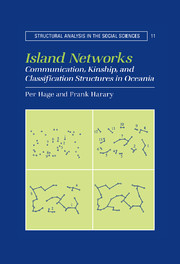8 - Digraphs
Published online by Cambridge University Press: 06 August 2010
Summary
It goes without saying that … merely formal studies can never be an end in themselves. But there is, on the other hand, always the danger that in historical or functional studies of kinship problems this formal aspect may be unduly neglected.
Paul Kirchhoff, “Kinship Organization”There have been two major attempts to construct formal evolutionary models of kinship organization in Oceania: Murdock's (1949) derivation of Malayo-Polynesian societies from a Hawaiian prototype, and Marshall's (1984) derivation of Island Oceanic sibling terminologies from a distributional prototype. Murdock's model, known more generally as the “bilateral hypothesis,” is part of a universal theory of social evolution representing the culmination of a lifetime of cross-cultural research on kinship organization, while Marshall's model is the most recent contribution to a theoretical discussion of sibling classification and social organization which began with the ethnographic researches of Codrington (1891) a century ago. Both models are controversial, primarily because of arguments from historical linguistics (Blust 1980, 1984; Bender 1984; Clark 1984). But there are problems of interpretation as well. Our purpose is to examine the graph theoretic foundation of these models. We will find that Murdock's model provides no valid reason for inferring that kinship organization in Proto-Malayo-Polynesian (PMP) society was Hawaiian in type. If anything, it was Iroquois or Nankanse, neither of which is a bilateral type of social organization. We will see that Marshall's model can be replaced by the one implicit in Milke's (1938) historical reconstruction of Proto-Oceanic (POC) sibling terms.
- Type
- Chapter
- Information
- Island NetworksCommunication, Kinship, and Classification Structures in Oceania, pp. 218 - 261Publisher: Cambridge University PressPrint publication year: 1996



